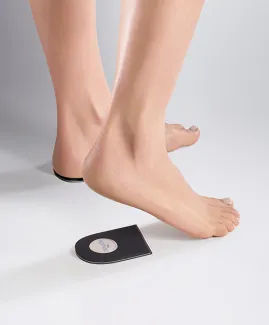
In the morning, your first steps are painful, as if a nail is piercing your heel. It may be a heel spur or plantar fasciitis. But how to identify them clearly? How are heel spurs diagnosed?
Find out the exams required for the diagnosis of plantar fasciitis: X-ray, MRI, physical exam… and what specialist to see to get the proper treatment.
Who to see for plantar fasciitis: podiatrist, chiropractor, doctor?
Several healthcare professionals can make the diagnosis of plantar fasciitis or heel spur. If you think you have the condition, you should consult your general practitioner. According to the stage of plantar fasciitis, an X-Ray and an MRI (Magnetic Resonance Imaging) can be performed to assess the presence of an inflammation or a heel spur.
He can also recommend you to see a podiatrist if you need orthopaedic insoles and prescribe sessions with a physical therapist to stretch the plantar fascia. Many people ask if a chiropractor can help with plantar fasciitis. Chiropractors are specialised in the diagnosis and treatment of spine and joint disorders, so he is not directly specialised in the diagnosis of plantar fasciitis.
Definition of talalgia: plantar fasciitis
Talalgia means heel pain. But this pain can affect different areas of the heel and have several causes. In the case of an infracalcaneal discomfort (under the heel) and after a thorough clinical examination by a health professional, the inflammation of your plantar fascia may be confirmed.
Plantar fascia is a fibrous band of tissue that links up the heel and the base of the toes. Not very elastic and located in the superficial layers of the plantar surface, it covers the other anatomical structures of the foot. The main functions of the fascia are:
• suspension;
• adhesion to the ground;
• foot support;
• role in the propulsion phase with contribution to force transmission.
There are three main types of fascia injury: enthesopathy, plantar fasciitis(diffuse pain in the fascia) and rupture.
Enthesopathy, or pain in the insertion of the plantar fascia on the heel bone, is very frequent. It is closely linked with the presence of a heel spur. The latter is the consequence of an excessive traction on the fascia, at its insertion point, leading to microtears.
The body tends to fight against this process by creating bone cells to strengthen the area subject to excessive use. These cells accumulate until forming a spur on the calcaneus, also called heel spur or calcaneal spur. However, the spur is not the one responsible for pain.
There is also plantar fasciitis, which is a pain in the fascia, under the arch of the foot.
Finally, another possible involvement is the rupture of the plantar fascia corresponding to its partial or complete tear.
These 3 conditions mainly result from mechanical problems. This article won’t deal with the inflammatory involvement due to diseases like ankylosing spondylitis.

How to diagnose heel spurs?
After some questions by the physician to assess your pain, some clinical and imaging tests can help diagnose plantar fasciitis. How is established the diagnosis of heel spurs and diagnosis thanks to the clinical examination?
First step in the diagnosis of plantar fasciitis: the clinical exam
Very often, the pain manifests at the inferior surface of the heel (anteromedial aspect). It occurs from the first steps in the morning and decreases after about 15 minutes. It can also happen after prolonged efforts like intense running. This pain progressively appears, at first in the dominant foot.
Your answers to the physician’s questions about the pain onset, intensity, frequency and link with some supports are precious indications.
The most frequently identified symptoms during the clinical examination are:
• Pain on palpation of the insertion point of the fascia on the calcaneus (this pain is precise or localised);
• Pain can be more intense if the fascia is put under passive stress (ankle flexion and hallux extension);
• Absence of swelling (if it is swollen, it could indicate a fatigue fracture or plantar fascia rupture).
It is also possible to reveal a static or dynamic disorder of the foot and/or of the leg.
MRI and X-Ray for plantar fasciitis
Your physician may prescribe you an MRI or an X-ray for your plantar fasciitis to eliminate all the differential diagnoses. In the case of plantar fasciitis, X-Rays are used to assess the presence of a heel spur. Indeed, this technique allows a view of bones inside the body.
On the contrary, an MRI is useful to see the soft tissues of the body. It would reveal the inflammation or the tear or rupture of the plantar fascia for example.

What should I do if I have a diagnosis of plantar fasciitis?
Once the diagnosis of plantar fasciitis is confirmed, your physician will provide you a treatment to suppress the symptoms (pain, sensitivity...) and eliminate the cause (inflammation, microtears, etc.).
In addition to massages and physiotherapy sessions, some stretching and muscle strengthening exercises can relieve pain. Those exercises mainly concern the Achilles tendon, the plantar fascia and the calf muscles.
Non-steroidal anti-inflammatory drugs can also complete the treatment protocol in case of inflammation.
These treatments for plantar fasciitis are often combined with the use of shoe inserts aiming to absorb shocks and slightly lift up the foot to reduce stresses.
EPITACT® has created the heel lifts* composed of two materials. The PHYSIO’CHOC™ is a material that softens the impact of the foot to the ground while the silicone gel in the centre makes supports more comfortable and distributes pressures. Foot pain is then relieved, walking and daily support are facilitated.
Lastly, patients with plantar fasciitis can wear goot arch support shoes with a cushioning sole.
Diagnosing plantar fasciitis is usually quick and simple. Medical imaging can reveal a heel spur, which most of the time goes unnoticed until the x-ray is done.
*This solution is a class I medical device that bears the CE marking under this regulation. Carefully read the instructions before use. Manufacturer: Millet Innovation. 10/2021
 Pharmacie
Pharmacie